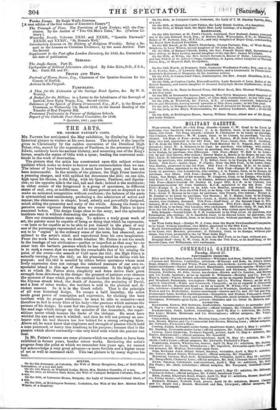THE ARTS.
MR. GEORGE PATTEN'S C0111.
Mn. PATTEN has anticipated ,the May exhibition, by displaying his large historical picture to visiters at his own house. The subject is the impulse given to Christianity by the sudden conversion of the Druidical High Priest; who, moved by the expositions of Paufinus, in the presence of King Edwin, suddenly hates his ancient idolatry, and mounting one of the King's horses, assails the statue of Odin with a spear; leading the converted mul- titude in the work of destruction.
The picture that the artist has constructed upon this subject evinces qualities which make us desire to bestow more commendation than we can. The labour of love bestowed upon it must have been great, and has not been unsuccessful. In the middle of the picture, the High Priest bestrides a prancing charger, and with uplifted fist denounces the idol; on one side, high upon his throne, is the King, with his Queen, Paulinus, and dignita- ries; on the opposite side is the idol, tall and dark; behind is the multitude; in either corner of the foreground is a group of spectators, in different states of zeal, awe, or indifference. All these persons are so disposed as to make an animated composition without confusion; the balance of the parts is symmetrical and satisfactory, producing a due admixture of action and repose; the chiaroscuro is simple, broad, soberly and powerfully designed, much aiding the symmetry and unity of the whole. Among the forms we -perceive more vigorous drawing than we remember Mr. Patten to have executed before. The design keeps close to the story, and the episodical incidents vary it without distracting the attention.
Here our commendation must stop. To achieve a truly great work of art, the painter must be capable of being or doing that which he represents, -at least so far capable as to be able to put himself in the place of any one of the personages represented and to enter into his feelings. Nature is not to be " copied " in the ordinary sense of the term, but observed, assi- milated to the artist's mind, and reproduced from his own imagination. From the work before us, we doubt whether Mr. Patten is not too much in the bondage of our civilization-perfect or imperfect as that may be-to enter into the barbaric passions which he has undertaken to portray. It is to such a reason that we ascribe the remarkable fact of his missing the point of the event-the assault of Coifi upon the idol: the High Priest is actually turning from the idol; on his prancing steed he dallies with his purpose; and the idol is assailed by others before spectators whose most lively expression does not outrage the subdued manners of our own re- spectable island in this age of decorous constraint. In the high style of art at which Mr. Patten aims, simplicity and force derive their great strength from directness in the design: the greatest of painters ever chooses the moment of time which gives the cardinal incident for his design-as in the Elymas struck blind, the death of Ananias, the anointing of David, and a host of other works; the incident is told in the plainest and di- rectest manner. So it is in the Greek reliefs. That is the principle of all true historical design. To escape a bald literality, the artist needs great power of conception and expression, for clothing the bare incident with its proper attributes: he mast be able to conceive-and therefore to feel in every fibre of his body-the passions which animate the persons of his design; he must feel the phrensy in which the priest is rapt, the mad rage which strings up the muscles of the iconoclast, the super- stitions terror which loosens the limbs of the idolater. He must have wielded the axe and seen it wielded; and then he will not portray an axe- bearer with his tool thrown too low behind for a strong swinging blow. Above all, he must know that singleness and strength of passion which hold a man possessed, or hurry him headlong to his purpose; because that is the passion which shows outwardly-the only kind with which the painter can deal.
In Mr. Patten's rooms are some pictures which we recollect to have been exhibited in former years, besides minor works. Reviewing the artist's progress from the point at which we remember him years ago, we cannot but acknowledge a very great advance-a more forcible and a higher sense of art as well as increased skill. This laet picture is by many degrees his best.


























 Previous page
Previous page